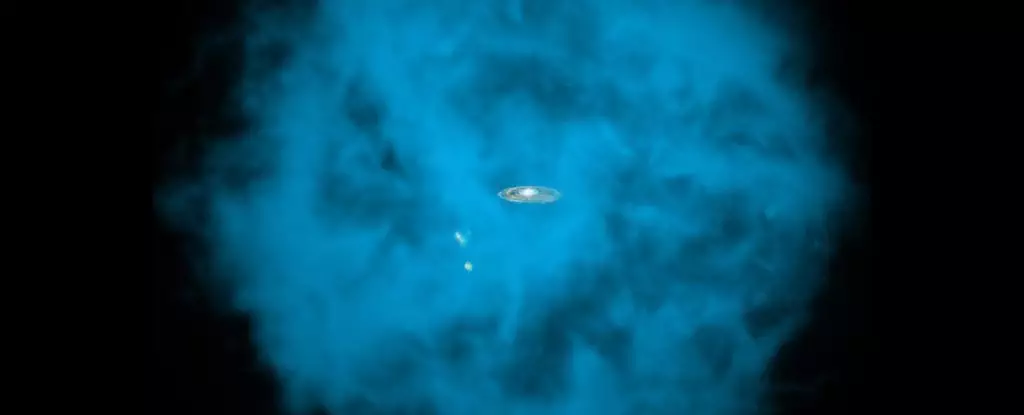For decades, scientists have wrestled with a profound enigma: where is the missing baryonic matter of the Universe? While we’ve successfully mapped a significant portion of the cosmos, more than half of the visible matter—primarily hydrogen—has remained elusive. This issue isn’t merely a scientific curiosity; it has implications for our understanding of cosmic formation and the very fabric of the stellar landscape. A significant breakthrough has recently emerged that could provide clarity in this celestial puzzle, revealing that the absent mass is not lost, but instead, residing as vast, unseen clouds of ionized hydrogen scattered throughout the empty space between galaxies.
The Role of Ionized Hydrogen Clouds
The research, led by an international team of astronomers and astrophysicists, utilizes innovative techniques to unveil these hidden reservoirs of hydrogen. Traditional observational methods have failed to capture this gas due to its diffuse nature and faint glow. However, this team proposes a fresh approach—utilizing changes in light patterns from the cosmic microwave background (CMB). As light from beyond our galaxy traverses these intergalactic spaces, it interacts with the ionized hydrogen, causing observable effects. This method, known as the kinematic Sunyaev-Zel’dovich effect, allows astronomers to ‘see’ the normally invisible clouds by detecting subtle variations in the cosmic light that permeates the Universe.
In essence, these ionized clouds represent the bulk of the missing baryonic matter. The implications of this discovery are monumental; they not only challenge previous assumptions about the distribution of matter in space but also suggest that the Universe may be considerably richer and more complex than we had envisioned.
Cosmic Implications and Galactic Evolution
At the heart of this research lies a powerful observation: the hydrogen halos surrounding galaxies are significantly larger than previously anticipated. The expanded search field suggests that researchers are close to recovering the entirety of the Universe’s missing hydrogen. This finding begs further exploration into the mechanics of galactic evolution. The interaction between supermassive black holes and hydrogen clouds presents another fascinating layer to our understanding of cosmic behavior. When these black holes undergo active phases, they generate immense jets and winds that influence the movement and distribution of gas, directly affecting star formation processes.
The newfound understanding of hydrogen halo dynamics and black hole activity raises vital questions about the episodic nature of black holes. Are these massive entities frequently dormant, only to flare up under certain cosmic conditions? Such insights are invaluable to the study of galactic formation and evolution.
The Power of Advanced Techniques in Astronomy
The techniques employed by the research team signify a crucial advancement in astronomical methods. Their stacking approach—layering observations to amplify insights—has unlocked a wealth of information about the structure of the Universe. By analyzing over a million glowing red galaxies within an 8 billion light-year radius of the Milky Way, the research found that the hydrogen halos are far more extensive than previous models had suggested. This novel technique showcases the potential of combining traditional observational astronomy with innovative methods of data analysis, paving the way for future discoveries in the cosmic landscape.
While the findings are exhilarating, they also pose new questions that challenge existing theories. For example, how does the hydrogen halo interplay with the known filaments of dark matter? This relationship may hold the key to understanding not only the whereabouts of the missing baryons but also the overall structure of the Universe.
Charting New Frontiers in Cosmology
This groundbreaking work has opened up a new frontier in cosmology, allowing researchers to investigate the intricate relationship between baryonic matter and dark matter more closely. Understanding this connection could radically transform our knowledge of galaxy formation, potentially reshaping our theoretical frameworks.
As we venture deeper into the mechanisms that govern the Universe, the implications of this research could resonate across disciplines within astrophysics, offering fresh insights into long-standing debates about cosmic evolution and composition.
Indeed, this multifaceted exploration underscores the continuously evolving nature of our understanding of the Universe. As scientists confront the complexity of cosmic structures, each revelation encourages further inquiry, leading to an even deeper appreciation for the astoundingly intricate tapestry of which our Universe is woven. The journey to uncover the truth behind these invisible gas clouds is only beginning, but the promise it holds is as fascinating as the mysteries it aims to unravel.


Leave a Reply